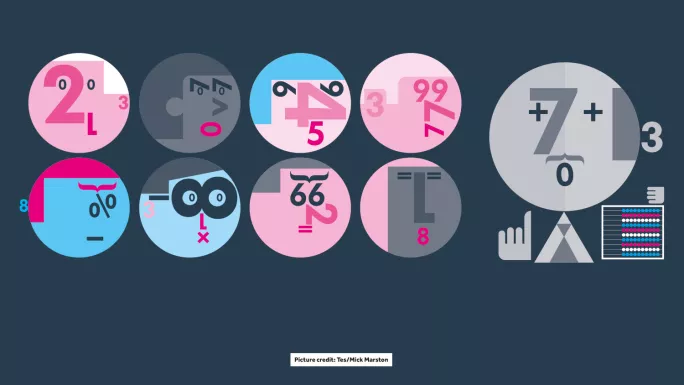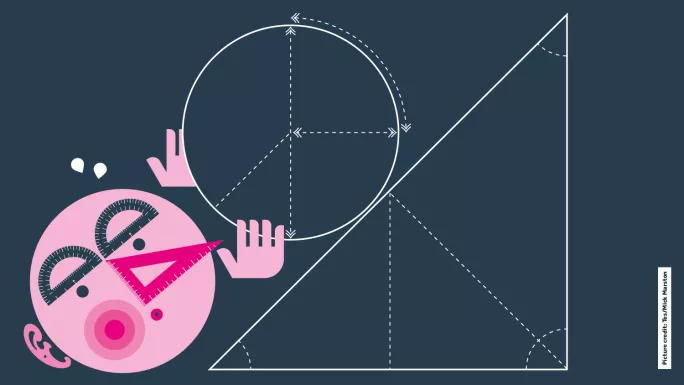- Home
- A desıgn for life
A desıgn for life

It was 1.30am and I had to be up in a few hours’ time if I was going to make it to an early morning lecture on vector multiplication. Yet sleep was not an option: I couldn’t help but sit, transfixed, at the screen.
Line by laborious line, the computer was etching a portrait of unearthly colours and razor-sharp patterns. Parts of the image looked like the fronds of a fern curled up on themselves, but the hues made it appear as if someone had spilled tubs of neon highlighter ink all over the picture. I felt as though I’d just landed on an alien planet and was surveying a landscape where the physical laws had nothing to do with the world I’d grown up in.
I looked closer: the colours bent and swirled around in ways that a human being surely could never have designed, and yet there was an undeniable pattern that seemed to stretch into infinity and that betrayed the intentionality with which the image was constructed.
What was going on?
- This was originally published in Tes magazine. To get great content every week, click here.
My older brother, the person who had started the computer off on this 24-hour mission in the first place, told me that this shape was called the Mandelbrot Set.
“It’s mathematics,” he assured me. “The spectrum of colours shows you how rapidly each complex number escapes along the iterated function system.”
I didn’t know what any of that meant. But that didn’t matter. It was in those early hours of that morning when I first realised that mathematics was so much more than just a list of arbitrary rules that I could use to solve a set of equally arbitrary problems.
And as I learned more about this shape - which mathematicians call a “fractal”, named after its fragmented and broken appearance (it comes from the same root word as “fraction” and “fracture”) - I discovered there was a whole cosmos of mathematical meaning and reality out there that I had never bothered to look up at, despite it being in the sky above my head the whole time. It was as if I had spent my entire life thinking that the only kind of music in existence was the scales I had been commanded to endlessly repeat in my preliminary piano lessons, but then I had suddenly heard a symphony for the first time.
If this bizarre object was made of maths, then that meant maths had to include both creativity and artistry. It was an endeavour filled with a spirit of exploration and discovery. I’d never associated any of that with maths. The vast majority of us don’t.
This is a problem. To fix it, we maths teachers need to show students the cosmos, we need to play them the symphony. But how?
The spirit of the subject
I count myself as one of the lucky ones. Maths is compulsory for a significant portion of formal schooling in almost all developed countries, so it’s safe to say that a wide section of the human population has experienced “mathematics” in their education. But I would contend that only a small subset of those people has ever truly encountered the genuine spirit of learning mathematics - I was fortunate that my brother opened the door for me.
I see the impact of that deficit in the attitudes of the students I interact with: it’s hard to avoid the conclusion that this is why so many people have learned to hate the subject.
For many, the word “mathematics” conjures up memories of boring classes in which they were forced to repetitively manipulate meaningless symbols against their will.
As if that were not a frustrating enough experience in itself, most of the time, students were expected to memorise inexplicable rules to solve contrived problems that no one cared about.
Governments around the world are urgently searching for the reason why generations of students are growing up without the science, technology, engineering and maths (Stem) skills that their economies so desperately need. All they need to do is step into a typical mathematics classroom.
How have we come to this point?
Somewhere we must have become unhinged, because the fact is that mathematicians down the ages have waxed lyrical about the inherently creative nature of mathematics.
Alfred Whitehead put it this way: “The science of pure mathematics, in its modern developments, may claim to be the most original creation of the human spirit.”
GH Hardy, another English mathematician, put it in even more concrete terms: “A mathematician, like a painter or poet, is a maker of patterns. If his patterns are more permanent than theirs, it is because they are made with ideas.”
Contemporary mathematics education, for the most part, struggles to live up to these lofty thoughts. There are many reasons why, but prime among them is that it is simply the path of least resistance for teachers and educators to settle into a view of mathematics that is almost entirely procedural in nature.
As someone with very little culinary skill, I can empathise with this. I don’t know what baking powder is or what it does. I haven’t the faintest clue why 180C is such an important temperature. But give me a recipe with step-by-step instructions, and I can bake you a pretty decent cake.
Teaching someone to replicate the steps of an algorithm - whether it’s to make a meal or find the roots of a quadratic equation - is objectively quicker and easier than taking the time and effort to help someone understand how those steps work or even why learning those steps is important.
Students don’t take long to absorb this attitude by osmosis. One time, when taking a class I don’t regularly teach, I asked the students a question midway through my explanation of a concept.
“So, what’s the actual reason why multiplying two negative numbers gives you a positive answer, anyway?”
I was met with puzzled stares. One girl eventually broke the silence.
“Just because, sir. Because math.”

To deal with a subject that she evidently found confusing, this girl’s coping strategy was to repress the normal human curiosity that begs for understanding. She had learned that accepting things without explanation was easier than pushing for comprehension and understanding.
It’s an approach that I see alarmingly often and it breaks my heart every time I meet it. I think this is the crux of why mathematics has such an image problem: our culture has advanced to a place where highly educated people can proudly declare that they were “never any good at mathematics”, almost as a badge of honour showing that they survived that dark valley of their schooling experience and have proved that they can function in society without it. The reason this attitude can prevail is because people have such a poor grasp of what mathematical thinking actually is and how deeply woven it is into our daily experience, not to mention our modern world as a whole.
Overcoming inertia
The situation may appear bleak, but change is possible. I know because of my own school experience: I grew up in a mathematical learning environment that very much prized acquiescence over argument and speed over sapience, but I was able to discover the importance of critical and creative thinking in mathematics later in life. I’ve also had my hope confirmed by seeing the lights come on for hundreds of my students throughout my teaching career.
How can this be done? How can we recover the fact that mathematics is personal first and procedural second?
Below are three simple suggestions that we can all start acting on as soon as tomorrow in our classrooms: they are to do with individual conversations, classroom dialogue, and the narrative of our teaching.
But before we come to the practical suggestions, I should point out that if we are trying to produce a personal attitude change in our students, then we must begin with our own beliefs and views of maths. These suggestions are not simple techniques that can be employed in an emotional vacuum and expected to successfully effect change. They must come in the context of a teacher whose underlying attitude shows that they themselves are moving in a direction consistent with what these techniques are trying to convey. It’s self-evident that no teacher can lead their students to a place they themselves have not been.
With that addressed, here are the three steps as I see them:
1. Individual conversations
Firstly, we must change the way we speak to individuals in the classroom. We interact with students hundreds of times over the course of a single week, and every interaction contributes to the overall atmosphere in our class. It’s tempting to believe that a single conversation is hardly a big deal, and that may be true in isolation. But just as a barrage of raindrops can cause a flood in the right quantity, the sheer volume of our student interactions means that our conversations have an appreciable effect on our students and shape their attitudes toward our subject.
Do you encourage students when they make mistakes, or do you berate them? Do you push students to understand why their answer went wrong or are you content to tell them the right answer and just implore them to accept it on your authority? Do you thoughtfully guide students in their struggle with a particular problem or do you immediately point them to the solution? Where you sit on the spectrum of each of these questions decisively determines whether or not your students appreciate and embrace the personal side of maths.
2. Whole-class dialogue
Secondly, consider the dialogue you have with your class whenever you stand at the front of your room and converse with everyone at once. How would you describe your verbal and body language when you’re there? What sense do your words and tone communicate to your students about the subject matter you are engaged in? Do your posture and demeanour show students that you have engaged in a personal struggle to understand this, too, or do you come off as someone who effortlessly understands everything? Is your body framed and moving in a way that demonstrates your emotional engagement with the content you are about to share, or does it betray the fact that you are actually bored by what you’re teaching that day? (And if we are bored with what we are teaching, then why are we ever surprised when students are bored with their learning?) Every teacher embodies their subject to their students. We are the lens through which they perceive whether these ideas are important, beautiful and precious - or pointless but compulsory. Our success or failure to communicate genuine passion in our teaching will show our students, by example, whether it is worth personally investing in maths or not.

3. Lesson narratives
Thirdly, we can shape the narrative of our teaching to constantly remind students of the personal journeys that lie just beneath the surface of the concepts and skills they are working to understand. A perfect example of this presented itself to me last year when I was teaching geometry to my Year 8 class. As is reflected by many well-meaning textbooks, geometry for a student in the early years of high school often begins with a review of the definitions and properties of various shapes (points, lines, polygons and so on) that were introduced in the past and form the foundation of deductive geometry. But there is nary a whisper of Euclid’s earth-shaking axioms, Lobachevsky’s astonishing curved world, Mandelbrot’s wrestle to reconcile the perfection of Euclidean polygons with the jagged self-similarity of the world around us (which eventually gave birth to that fractal that so dazzled me).
There is seldom a hint of the fact that geometry is actually a field in motion, being driven forward today by brilliant and determined human beings. Instead, geometry is often taught as a monolithic structure of knowledge delivered down from the heavens since time immemorial. That is why, in my introduction to the topic, I told my class to title it “The Global and Historical Geometry Project.” This name reflects the fact that the students are doing much more than memorising propositions etched in immutable stone tablets. Rather, they are dipping their toes into the great rolling ocean of geometric logic and reality - an ocean that humanity has been surfing for centuries.
The moon-shot of our time
John F Kennedy, in his famous address at Rice University in which he declared his intent to land a man on the Moon, pointed to the difficulty of the space exploration not as a detractor but rather as a powerful motivator. His gambit paid off: the US overcame huge technical and social challenges in its bid to win the space race; the Apollo programme went down in history as one of mankind’s crowning achievements.
Transforming the attitudes and beliefs of a global culture toward mathematics is similarly daunting. You could even say that it’s more so: Nasa was dealing with the constraints of material science and aerospace engineering, but as educators we are trying to overcome cognitive, emotional and social realities that have become entrenched in human culture. In many ways, it’s much easier to design a rocket than it is to change a person’s mind.
But there is so much at stake that we are under a moral imperative to fundamentally transform the way we learn and teach maths in our schools. And if we succeed, it won’t just be the lunar surface but a whole universe that we can unlock for our children.
Eddie Woo is the head teacher of mathematics at Cherrybrook Technology High School in Sydney, Australia, and the creator of Wootube, a Youtube channel on which he freely shares videos of his daily classroom teaching
Register with Tes and you can read two free articles every month plus you'll have access to our range of award-winning newsletters.
Keep reading with our special offer!
You’ve reached your limit of free articles this month.
- Unlimited access to all Tes magazine content
- Save your favourite articles and gift them to your colleagues
- Exclusive subscriber-only stories
- Over 200,000 archived articles
- Unlimited access to all Tes magazine content
- Save your favourite articles and gift them to your colleagues
- Exclusive subscriber-only stories
- Over 200,000 archived articles